Ashgabat in Turkmenistan – Absurdistan or Pyongyang II?
Friday, 16 June 2017We’re now in Mashhad in Iran on Day 76 of our 102 day Silk Road odyssey by MGB. Our last stop in the Central Asian ‘stans – Kazakhstan, Kyrgyzstan, Uzbekistan and Turkmenistan – was at Ashgabat, the capital of Turkmenistan. None of the ‘stans were what I expected, Kyrgyzstan in particular was a complete surprise: one minute it’s the Swiss Alps, then it’s cosmopolitan European café society, then we’re beside a lake in New Zealand before suddenly horsemen ride by yurts as if this was Mongolia. Deserts? Classic Islamic architecture? They are there, but only part of the picture.
And suddenly we arrived in Ashgabat and it was … well perhaps Absurdistan (with apologies to author Gary Shytengart), or perhaps it was Pyongyang crossed with Dubai. I’ve regularly listed my three weirdest countries as North Korea followed by Saudi Arabia followed by Israel. Perhaps Turkmenistan should elevate itself into that weird company? And Pyongyang was easily the weirdest city I’ve ever seen until I arrived in Ashgabat.
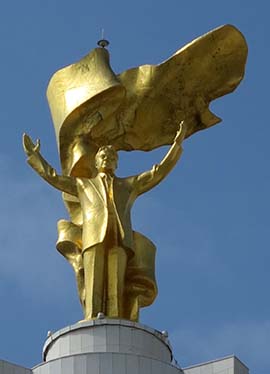 ◄ Most of that weirdness was the product of the imagination and overwhelming vanity of the (now deceased) Turkmenbashi, Saparmurat Niyazov. During his rule he renamed himself the ‘Head of the Turkmen,’ built enough white marble architecture to put Ashgabat at the top of The Guinness Book of Records white marble rankings, banned listening to radios in cars, renamed the days of the week after his children, well the list goes on. But most important he dotted the country with gold statues of himself, most notably this one on top of the Arch of Neutrality. During his reign the 12-metre-high statue rotated so that he always faced the sun from sunrise to sunset. It’s now stationary, but the gold still gleams.
◄ Most of that weirdness was the product of the imagination and overwhelming vanity of the (now deceased) Turkmenbashi, Saparmurat Niyazov. During his rule he renamed himself the ‘Head of the Turkmen,’ built enough white marble architecture to put Ashgabat at the top of The Guinness Book of Records white marble rankings, banned listening to radios in cars, renamed the days of the week after his children, well the list goes on. But most important he dotted the country with gold statues of himself, most notably this one on top of the Arch of Neutrality. During his reign the 12-metre-high statue rotated so that he always faced the sun from sunrise to sunset. It’s now stationary, but the gold still gleams.
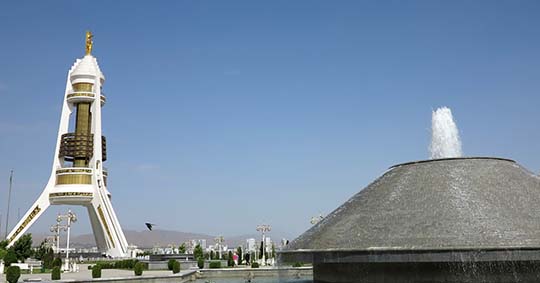 ▲ The Arch of Neutrality and one of the numerous fountains that surround it. What it was not surrounded by was people, in the daytime it was deserted, like most of Ashgabat.
▲ The Arch of Neutrality and one of the numerous fountains that surround it. What it was not surrounded by was people, in the daytime it was deserted, like most of Ashgabat.
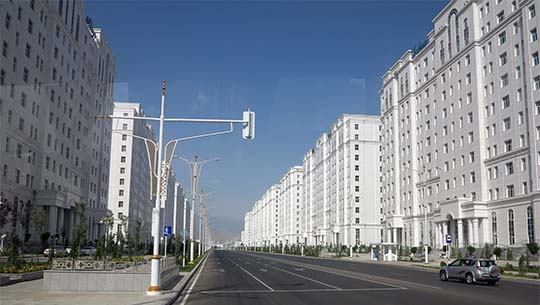 ▲ Its sheer emptiness is one of the most compelling images of the city. You look down vast avenues lined by white apartment blocks and there’s nobody, the occasional car cruises by, but people?
▲ Its sheer emptiness is one of the most compelling images of the city. You look down vast avenues lined by white apartment blocks and there’s nobody, the occasional car cruises by, but people?
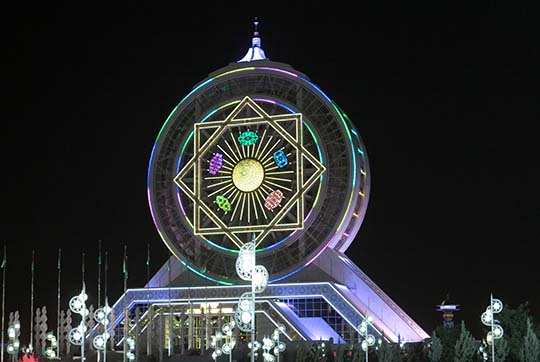 ▲ The Alem Entertainment Centre’s indoor ferris wheel by night – yes ‘indoor’ and, of course, it’s the biggest indoor ferris wheel in the world.
▲ The Alem Entertainment Centre’s indoor ferris wheel by night – yes ‘indoor’ and, of course, it’s the biggest indoor ferris wheel in the world.
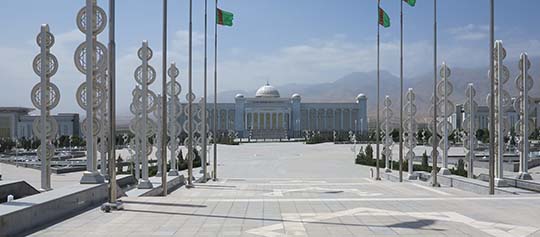 ▲ I was also there by day and from the front you looked out across a vast square and then across the main avenue, Arçabil şayoli, to some government office or ministry and what did you see? Well no people, nobody at all, just emptiness. The only noise was the flapping of flags, the splash of fountains, the chirping of birds, otherwise it felt like some dystopian, post-disaster movie set where the buildings are untouched, but the people are all gone.
▲ I was also there by day and from the front you looked out across a vast square and then across the main avenue, Arçabil şayoli, to some government office or ministry and what did you see? Well no people, nobody at all, just emptiness. The only noise was the flapping of flags, the splash of fountains, the chirping of birds, otherwise it felt like some dystopian, post-disaster movie set where the buildings are untouched, but the people are all gone.
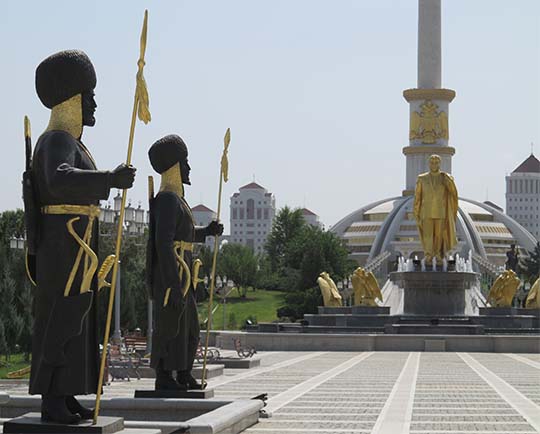 ▲Statues of heroes, the inevitable gold statue of the Turkmenbashi and the Monument to the Independence of Turkmenistan, known locally as ‘the plunger’ because it was clearly modelled after a toilet plunger. You can imagine the Turkmenbashi handing one to his architect and saying ‘make it look just like this, but 118-metres tall with lots of marble and gold.’
▲Statues of heroes, the inevitable gold statue of the Turkmenbashi and the Monument to the Independence of Turkmenistan, known locally as ‘the plunger’ because it was clearly modelled after a toilet plunger. You can imagine the Turkmenbashi handing one to his architect and saying ‘make it look just like this, but 118-metres tall with lots of marble and gold.’
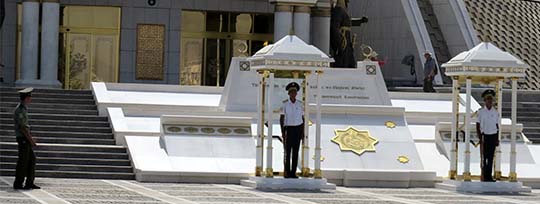 ▲ In front of the tower are the inevitable guards, two sentries standing rigidly to attention, rifles in hand, and a third guard whose function is to ensure that you don’t take photographs of the first two guards.
▲ In front of the tower are the inevitable guards, two sentries standing rigidly to attention, rifles in hand, and a third guard whose function is to ensure that you don’t take photographs of the first two guards.
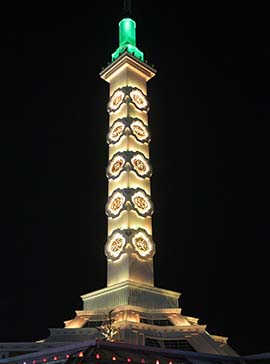 ◄ The 185 metre-high Monument to the Constitution at night. One of the pleasures of Ashgabat is discovering what you are not allowed to photograph, which essentially means any government building as a starter. But amongst all those white marble apartment blocks, offices, banks, memorials, libraries, museums and so on how do you know which one is the presidential palace or the ministry of something or other? There are no signs announcing ‘government building, do not photograph,’ but it’s easy to find the wrong building, just take a photograph. If it’s a government buildings a police officer, an army recruit or some plainclothes lackey will instantly jump out from where he’s been hiding behind a bush and yell at you.
◄ The 185 metre-high Monument to the Constitution at night. One of the pleasures of Ashgabat is discovering what you are not allowed to photograph, which essentially means any government building as a starter. But amongst all those white marble apartment blocks, offices, banks, memorials, libraries, museums and so on how do you know which one is the presidential palace or the ministry of something or other? There are no signs announcing ‘government building, do not photograph,’ but it’s easy to find the wrong building, just take a photograph. If it’s a government buildings a police officer, an army recruit or some plainclothes lackey will instantly jump out from where he’s been hiding behind a bush and yell at you.
As one Ashgabatian commented ‘this is 1984, half the population is employed to watch the other half.’ I only wish I’d had more time to enjoy this utterly crazy capital, the Asian Games will play out in Ashgabat in September 2017, a good time to be there.
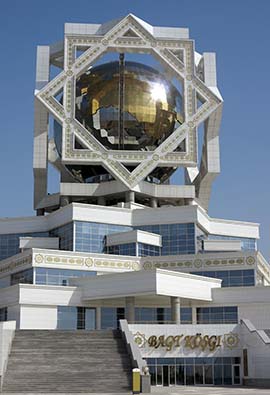 ◄ Finally the Wedding Palace, a combination of disco ball (Turkmenistan occupying most of the world) and multi-sided star perched on top of the building. In turn it tops a hill which is a good lookout point over the white marble expanse of Berzengi, the new city district of Ashgabat.
◄ Finally the Wedding Palace, a combination of disco ball (Turkmenistan occupying most of the world) and multi-sided star perched on top of the building. In turn it tops a hill which is a good lookout point over the white marble expanse of Berzengi, the new city district of Ashgabat.






